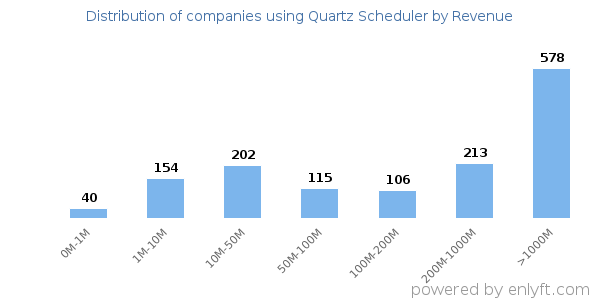Companies using Quartz Scheduler
We have data on 1,286 companies that use Quartz Scheduler. The companies using Quartz Scheduler are most often found in United States and in the Information Technology and Services industry. Quartz Scheduler is most often used by companies with >10000 employees and >1000M dollars in revenue. Our data for Quartz Scheduler usage goes back as far as 8 years and 8 months.
If you’re interested in the companies that use Quartz Scheduler, you may want to check out BMC Control-M and SaltStack as well.
Who uses Quartz Scheduler?
| Company | EPAM Systems Inc |
| Website | epam.com |
| Country | United States |
| Revenue | >1000M |
| Company Size | >10000 |
| Company | Globant |
| Website | globant.com |
| Country | Luxembourg |
| Revenue | >1000M |
| Company Size | >10000 |
| Company | SAP SE |
| Website | sap.com |
| Country | United States |
| Revenue | >1000M |
| Company Size | >10000 |
| Company | Accenture PLC |
| Website | accenture.com |
| Country | Ireland |
| Revenue | >1000M |
| Company Size | >10000 |
| Company | Zillion Group, Inc. |
| Website | healthfleet.com |
| Country | United States |
| Revenue | 10M-50M |
| Company Size | 50-200 |
| Company | Website | Country | Revenue | Company Size |
|---|---|---|---|---|
| EPAM Systems Inc | epam.com | United States | >1000M | >10000 |
| Globant | globant.com | Luxembourg | >1000M | >10000 |
| SAP SE | sap.com | United States | >1000M | >10000 |
| Accenture PLC | accenture.com | Ireland | >1000M | >10000 |
| Zillion Group, Inc. | healthfleet.com | United States | 10M-50M | 50-200 |
Target Quartz Scheduler customers to accomplish your sales and marketing goals.
Quartz Scheduler Market Share and Competitors in Workload Automation
We use the best indexing techniques combined with advanced data science to monitor the market share of over 15,000 technology products, including Workload Automation. By scanning billions of public documents, we are able to collect deep insights on every company, with over 100 data fields per company at an average. In the Workload Automation category, Quartz Scheduler has a market share of about 7.2%. Other major and competing products in this category include:
Workload Automation
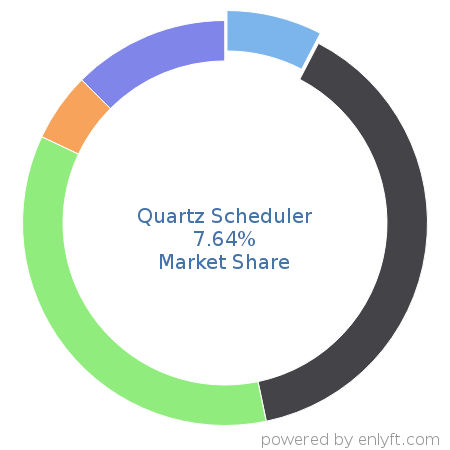

What is Quartz Scheduler?
Quartz is a richly featured, open source job scheduling library that can be integrated within virtually any Java application - from the smallest stand-alone application to the largest e-commerce system. Quartz can be used to create simple or complex schedules for executing thousands of jobs; jobs whose tasks are defined as standard Java components that may execute virtually anything you may program them to do. The Quartz Scheduler includes many enterprise-class features, such as support for JTA transactions and clustering.
Top Industries that use Quartz Scheduler
Looking at Quartz Scheduler customers by industry, we find that Information Technology and Services (22%), Computer Software (14%) and Financial Services (8%) are the largest segments.
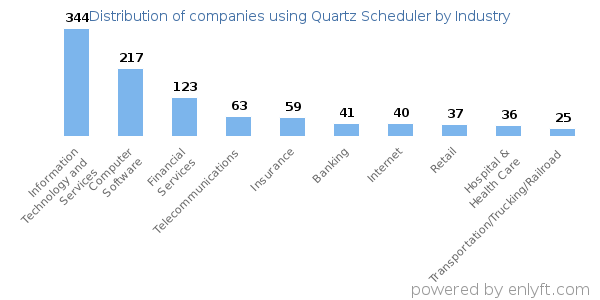
Top Countries that use Quartz Scheduler
62% of Quartz Scheduler customers are in United States and 8% are in India.
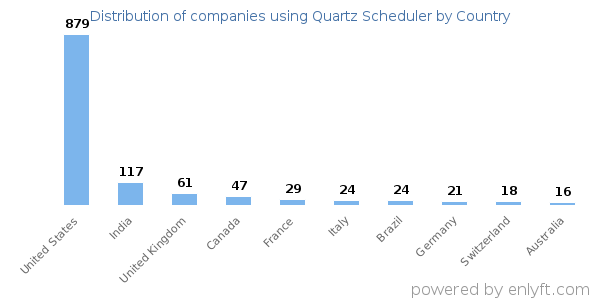
Distribution of companies that use Quartz Scheduler based on company size (Employees)
Of all the customers that are using Quartz Scheduler, a majority (55%) are large (>1000 employees), 14% are small (<50 employees) and 30% are medium-sized.
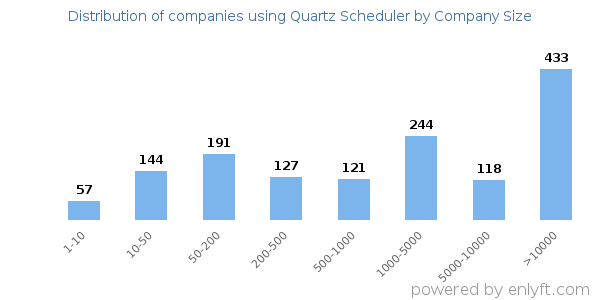
Distribution of companies that use Quartz Scheduler based on company size (Revenue)
Of all the customers that are using Quartz Scheduler, a majority (54%) are large (>$1000M), 26% are small (<$50M) and 15% are medium-sized.
